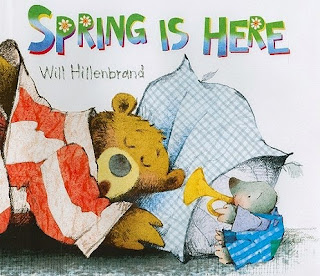Today, I had a BLAST reading Spring Is Here to a kindergarten class! I began by showing them the cover and reading the title. I asked the class to predict who the main character is and what the story is about. They had some amazing and insightful suggestions. The consensus was that Mole would try to wake Bear up from his winter hibernation.
As I read, I took the opportunity to point out the difference between reality and fantasy. I asked if moles really hibernate by sleeping in comfy beds like people. Of course, they knew moles do not. We differentiated between reality (hibernating/waking up when it is spring) and fantasy (sleeping in a bed in a little house/being friends with a bear).
As Mole walks over to his friend Bear’s house, he squish, squish, squishes through the mud. Then, he raps on Bear’s window—Tap, Tap, Tap. The only reply he receives from Bear is “Snore.” Next, Mole knock, knock, knocks on Bear’s door. Again, “Snore” is Bear’s reply. At this point, I introduced a new word: Onomatopoeia. I defined it as sound words, like squish, tap, snore, and knock.
The narrative continues with Mole trying various ways to wake up Bear, such as a feather on his nose and a horn noise. Bear always replies with “Snore.” I began to pause before each repetition of “snore” and invited the students to participate by “reading” it with me.
I praised the students for doing a wonderful job predicting who the main character is and what the story is about. When Mole scampers outside, I asked the students what they thought Mole would do next. One of my favorites is that he would go out to the river and get some water to dump on Bear. LOL No one predicted the right answer. On the next page where he is gathering eggs, milk, and butter, I asked the class again to predict what Mole is doing. They guessed he is making a pie. The students were close (It is pancakes, muffins, and other breakfast foods). Bear finally wakes up to the smell of Mole’s yummy food.
The children giggled at the ending:
“Yum,” replied Bear.
Then he looked at Mole.
“Wake up, Mole!” said Bear.
“Spring is here.”
(turn page—Mole is snuggled up next to Bear)
“Snore,” replied Mole.
At the end of the book, I asked the children to give me other examples of onomatopoeia. They had great ones both from the story and their own experiences. I also asked them to identify the beginning, middle, and end. With just a little guidance, they did a wonderful job relating the parts back to me.
I had only skimmed this book before this reading session. After reading it with the group, I realized how alive and exciting this narrative is.
I highly recommend Will Hillenbrand's Spring Is Here for ages 3-8. It is a fun read aloud selection with many teaching opportunities for parents sitting one on one or teachers in the classroom.
I highly recommend Will Hillenbrand's Spring Is Here for ages 3-8. It is a fun read aloud selection with many teaching opportunities for parents sitting one on one or teachers in the classroom.
For multiple readings with the same group or child, invite them to participate in reciting the repetitive patterned text. For other learning opportunities, you may want to discuss: the signs of spring, animal habits during spring, and the qualities of a good friend.








We have read several books illustrated by Will Hillenbrand but none written by him. This one sounds really cute! And I agree--it is gratifying to read to a receptive audience. :-)
ReplyDelete@Amy I enjoyed it so much that I hope to go be able to go back. Most of my reading these days is to myself :(
ReplyDelete